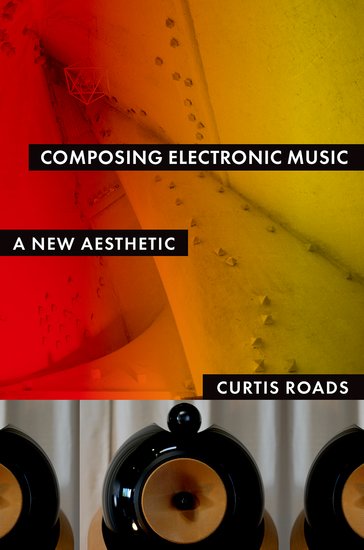Curtis Roads: Composing Electronic Music: A New Aesthetic (2015)
Filed under book | Tags: · composing, composition, electroacoustic music, electronic music, granular synthesis, music, rhythm, sound, technology

“Electronic music evokes new sensations, feelings, and thoughts in both composers and listeners. Opening the door to an unlimited universe of sound, it engages spatialization as an integral aspect of composition and focuses on sound transformation as a core structural strategy. In this new domain, pitch occurs as a flowing and ephemeral substance that can be bent, modulated, or dissolved into noise. Similarly, time occurs not merely as a fixed duration subdivided by ratios, but as a plastic medium that can be generated, modulated, reversed, warped, scrambled, and granulated. Envelope and waveform undulations on all time scales interweave to generate form. The power of algorithmic methods amplify the capabilities of music technology. Taken together, these constitute game-changing possibilities.
This convergence of technical and aesthetic trends prompts the need for a new text focused on the opportunities of a sound oriented, multiscale approach to composition of electronic music. Sound oriented means a practice that takes place in the presence of sound. Multiscale means an approach that takes into account the perceptual and physical reality of multiple, interacting time scales-each of which can be composed. After more than a century of research and development, now is an appropriate moment to step back and reevaluate all that has changed under the ground of artistic practice.
Composing Electronic Music outlines a new theory of composition based on the toolkit of electronic music techniques. The theory consists of a framework of concepts and a vocabulary of terms describing musical materials, their transformation, and their organization. Central to this discourse is the notion of narrative structure in composition-how sounds are born, interact, transform, and die. It presents a guidebook: a tour of facts, history, commentary, opinions, and pointers to interesting ideas and new possibilities to consider and explore.”
Publisher Oxford University Press, 2015
ISBN 9780195373233, 0195373235
xxvii+480 pages
Reviews: Nick Collins (Music and Letters, 2016), Gregory Taylor (Cycling74, 2016), Warren Burt (SoundBytes, 2016).
PDF (24 MB)
Companion website
Albert Glinsky: Theremin: Ether Music and Espionage (2000)
Filed under book | Tags: · biography, electronic music, music, music history, politics

“Leon Theremin led a life of flamboyant musical invention laced with daring electronic stealth. A creative genius and prolific inventor, Theremin launched the field of electronic music virtually singlehandedly in 1920 with the musical instrument that bears his name. The theremin-–the only instrument that is played without being touched-–created a sensation worldwide and paved the way for the modern synthesizer. Its otherworldly sound became familiar in sci-fi films and even in rock music. This magical instrument that charmed millions, however, is only the beginning of the story.
As a Soviet scientist, Theremin surrendered his life and work to the service of State espionage. On assignment in Depression-era America, he became the toast of New York society and worked the engines of capitalist commerce while passing data on U.S. industrial technology to the Soviet apparat. Following his sudden disappearance from New York in 1938, Theremin was exiled to a Siberian labor camp and subsequently vanished into the top-secret Soviet intelligence machine, presumed dead for nearly thirty years. Using the same technology that lay behind the theremin, he designed bugging devices that eavesdropped on U.S. diplomatic offices and stood at the center of a pivotal cold war confrontation. Throughout his life, Theremin developed many other electronic wonders, including one of the earliest televisions and multimedia devices that anticipated performance art and virtual reality by decades.
In this first full biography of Leon Theremin, Albert Glinsky depicts the inventor’s nearly one hundred-year life span as a microcosm of the twentieth century. Theremin is seen at the epicenter of most of the major events of the century: the Russian Revolution, two world wars, America’s Great Depression, Stalin’s purges, the cold war, and perestroika. His life emerges as no less than a metaphor for the divergence of communism and capitalism.”
Foreword by Robert Moog
Publisher University of Illinois Press, 2000
ISBN 0252025822, 9780252025822
xvi+403+[30] pages
Reviews: Irina L.Vanechkina (Leonardo, 2001), Hans-Joachim Braun (Tech Cult, 2001), Mark Polishook (Notes, 2001), Ann Warde (Comp Music J, 2002), Kyle Gann (Am Music, 2003).
PDF (138 MB, no OCR)
Comment (0)Für Augen und Ohren: von der Spieluhr zum akustischen Environment. Objekte, Installationen, Performances (1980) [German]
Filed under catalogue, video | Tags: · electronic music, experimental music, music, music history, musical instruments, musique concrète, performance, sound, sound art

Catalogue for a large-scale exhibition of sound art and mechanical and electronic music devices. Curated by René Block and Nele Hertling for the Akademie der Künste, West-Berlin, the exhibition included seven large gallery halls of sound sculpture, early electronic devices from the 1930s and 1940s, and sound environments.
With essays by Dieter Krickeberg, Siegfried Wendel, Wolf D. Kuehnelt, Juan Allende-Blin, Billy Klüver, René Block; chronology by Helmut Danninger.
Edited by René Block, Lorenz Dombois, Nele Hertling, and Barbara Volkmann
Publisher Akademie der Künste, Berlin, 1980
ISBN 3883319147
312 pages
Documentary directed by Detlef Michael Behrens, 1980
German language
33 min
Radio report (Charles Amirkhanian, KPFA-FM, 1980, EN)
Documentary: MP4 (107 MB, Vimeo)
Catalogue: PDF (88 MB, no OCR)

